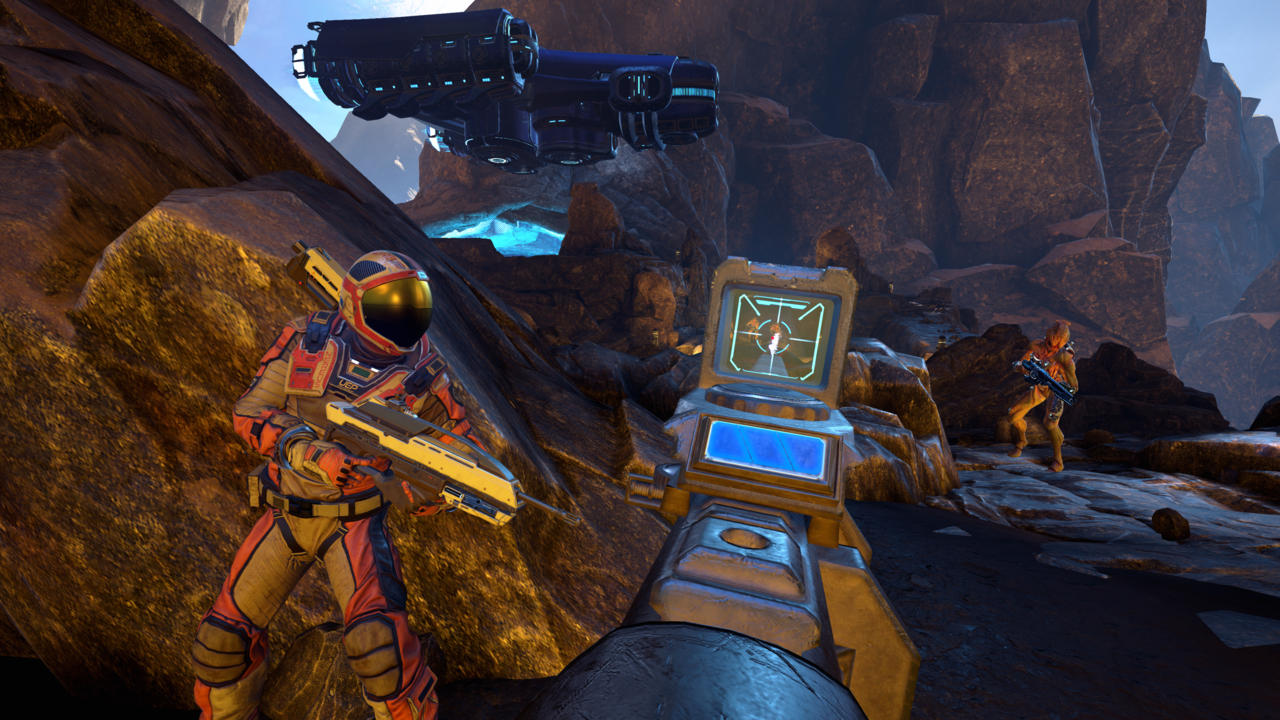The "what” of Farpoint isn't as vital as the "how.” Even among its virtual-reality-enabled peers, it's a fairly standard shooter about an unnamed space shuttle pilot who, along with two scientists, ends up stranded on an uncharted desert planet while investigating an anomaly near a wormhole orbiting Jupiter. When you wake up, you've got nothing but an assault rifle and your wits with which to face off against an ugly horde of arachnids. For much of the first half of the game, Farpoint is rudimentary, with linear--albeit pretty and atmospheric--desert corridors leading to open areas filled with enemies. Your weapons are shooter mainstays: an assault rifle and a shotgun, both with high-powered secondary rounds.
It's only after the first boss fight that it becomes clear Farpoint is a late bloomer. The lethargic first area acts as a proof-of-concept demo for the PSVR Aim controller--an optional accessory that can be purchased as a bundle with the game. To Farpoint's detriment, it means anyone playing the game with a DualShock 4--Farpoint doesn't support PlayStation Move controllers--will be bored to tears before being torn apart by the game's nimble, vicious little beasts.
For those who do splurge for the Aim, however, they'll find Farpoint's early hours show off all the slick ways the gun controller makes the difference between a boring game and an engaging one. Through the Aim, the otherwise lackluster desert corridors are a prime showcase for the kinetic motion and aiming that could only work in VR. One of the best tiny touches is the simulated holographic sight--modeled after real-world counterparts--that makes targeting encroaching enemies from a distance a more involved but satisfying process.

Once you move past this tutorial-like section, Farpoint starts bringing its surprises out of the bag. The generic bug hunt in haunting, sunbathed landscapes gradually transitions into a pulse-pounding, run-and-gun nightmare scenario against a slew of unforgiving murder machines. The weapons take on a delightful alien bent, with a decidedly different heft and feel from the basic assault and shotgun options of the first half. With infinite ammo for all of them--only explosive rounds and rockets need refilling--you'll walk into any firefight comfortably.
When bipedal aliens join the fight in the second half of the game, Farpoint becomes a true test of skill, and comes alive in a way the first half never hints at. Enemies suddenly know how to use cover, flank your position, and fire sniper rifles from afar. Sneaky killshots have to be carefully keyholed through minute gaps in wreckage with one eye closed and actual steady hand on the Aim controller. Alternatively, John Wick-style strolls down a corridor while blind-firing a shotgun and laying waste to a whole squad of enemies without breaking stride feels magnificent. Style and success in Farpoint are bound only by your own flexibility and guile.
And yet, the biggest surprise the game has in store has nothing to do with the gunplay but the overarching plot involving the two scientists, Dr. Grant Moon and Dr. Eva Tyson, who crashed on the planet first. Time away from gunning down aliens is spent examining holographic records of the doctors' prior escapades. While this builds toward a somewhat predictable conclusion, the particulars are breathtaking in their poignancy; a tonal clash with the rest of the game. Eventually, every cutscene is a hard emotional swerve, and the ultimate fate of Drs. Moon and Tyson feels ripped from a much different, heartbreaking experience than an arcade VR shooter.
The narrative dissonance fades away in the game's final third and feels like a long-lost memory once the chaos of combat returns. And after the credits roll, you're left with nothing but a series of challenge modes, remixing the enemy layout of each stage with a time limit and a point value for every dead bot or bug. These challenges can also be tackled as an online co-op experience, which may not make things any easier--but in VR, how two players decide to play is a much different kind of song and dance than the average cooperative Horde mode found in other games.
Despite shifting gears in surprising ways and extending the life of its gunplay by remixing levels, Farpoint is more like a proof of concept than a game designed to push the envelope on its own terms. It'll give you a taste of something new for PSVR, and give you hints of what to look forward to if the Aim controller attracts wider support. It's going to be hard to go back to two Move controllers now that Sony's new toy has made a case for itself.









